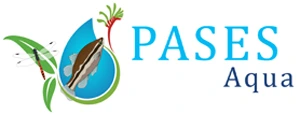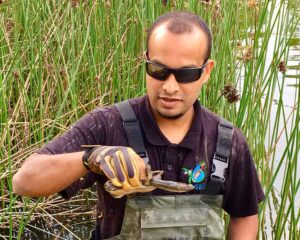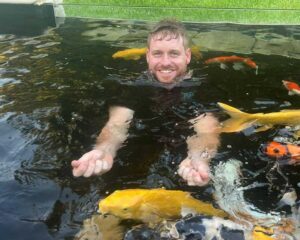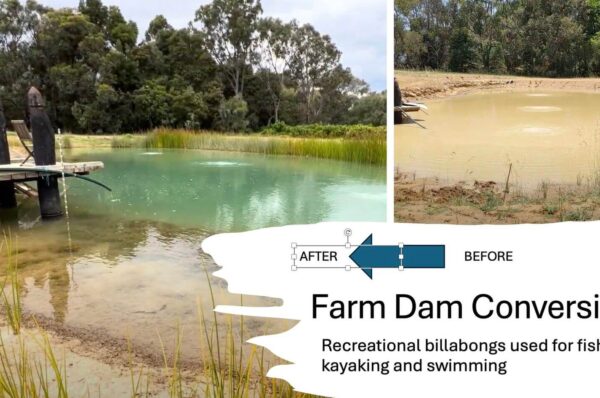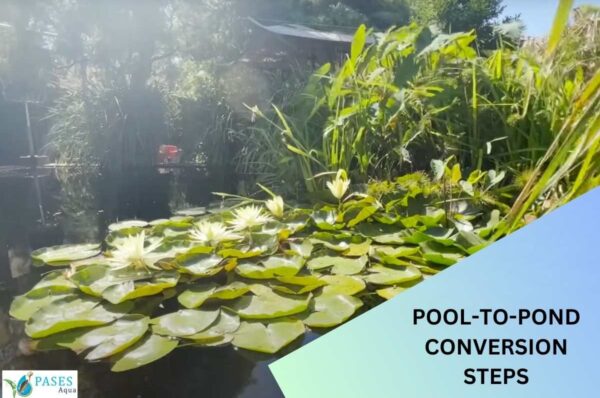If you have a pond, you know it takes a lot of work to keep it clean and healthy. But don’t worry, at PASES Aqua, we are here to help!
This article will teach you how to clean your pond like a professional. We will cover everything from choosing the right equipment to removing sludge and debris. So whether you’re a beginner or a seasoned pro, read on for all the tips and tricks you need to keep your pond looking its best.
What methods can be used to make pond water crystal clear?
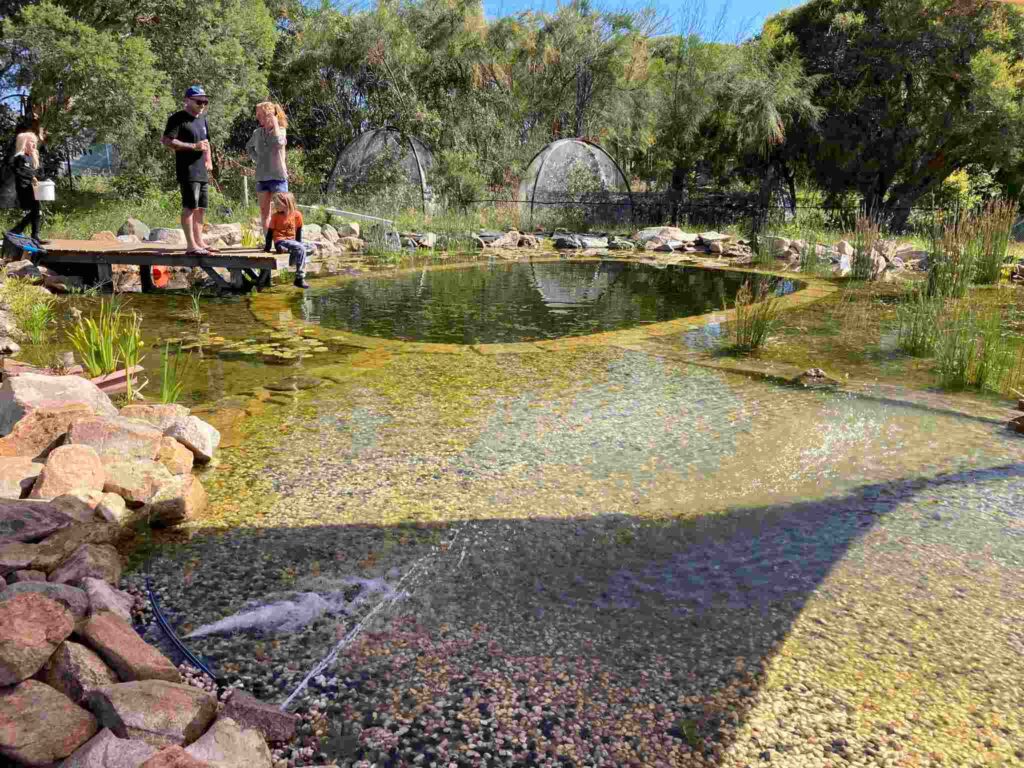
For most smaller ponds, it is recommended you have a submersible dirty water pump to move the water into a pressure filter outside, which ‘cleans’ the water. Most pressure filters have a UV clarifier, and mechanical and biological filtration media.
The sponge media traps the suspended particles such as sand, silt, clay and other organic media. The sponges also have a high surface area to volume ratio, allowing beneficial bacteria or microbes to break down nutrients in the water.
As the UV works away at zapping the microalgae, it causes algae to flocculate and can then be picked up by the pond filter and removed manually through a backwash.
These filtration systems, if maintained properly, will guarantee crystal-clear water.
Using a pond net, you should scoop out the sludge and heavy organic matter that’s fallen to the pond floor. Remember, not all particles will be sucked up from the pump as they are heavy and fall to the floor, especially in stagnant areas.
If the task is overwhelming, hire a pond cleaner, as they have large pond vacuums that can take out all the sludge within an hour for small ponds.
How can I naturally clear pond sludge?

Many products on the market claim to remove sludge by introducing certain bacteria that will consume the sludge over time. However, these products can only perform as well as your pond will allow them to. Certain factors, such as oxygen levels, fish stocks and temperature, can affect the results.
Another option is to add plenty of oxygen into your water column via water pumps and air pumps. The more oxygen your water has, the higher your beneficial bacteria colonies will be. This will ultimately help keep sludge levels slow in your pond as the bacteria decompose the sludge with time.
Should fish be removed when cleaning a pond?
Fish can be removed from your pond if required to complete a clean-out. For extreme cleans or even pond repairs, you may need to drain all of the water from the pond in order to get it back to a manageable state.
In this instance, it may be necessary to take the fish out and store them in a well-oxygenated container. If the pond cleaning is going to take multiple days to complete, it may also be required that you add some filtration to the storage container.
If the pond cleaning is able to be done without removing all of the water (pond vacuuming only), then you may leave the fish in the pond. The key is to reduce the stress of the fish as much as possible. There’s no point taking unnecessary risks.
How to keep your fish safe when removing and re-introducing them from your pond?
When removing your pet fish, there are a few steps to think about.
Firstly, you will need to consider how long they will be out of the pond.
If your fish are only going to be taken out for a few minutes then a smaller container or temporary pond could be used as long as the fish has space to move around.
If they are going to be out for a few hours or even a whole day, then you will need to make sure you have a large enough container that can hold plenty of water for the fish to swim as they normally would. The larger the container or temporary pond, the better.
You will then need to consider how you will oxygenate the water. The use of an air pump, water pump or ideally both will ensure your fish have plenty of oxygen to keep them happy while they are out of the main pond.
If the fish are going to be taken out for long periods of time, such as in the case of a pond repair. You will also need to add some kind of filtration to the system. Ideally, you could use the filter from the main pond and place it in the temporary pond, as this would have lots of beneficial bacteria.
If you cannot use the filtration from the main pond then daily water changes and regular water testing are advised for long-term stays.
Always try to use the water from the pond the fish are currently in to fill your temporary pond. This will reduce the shock of new water. If you have to use tap water then be sure to add the correct amount of water conditioner to make the water safe for your fish.
Lastly, you will need something to catch your fish. For large koi the use of a koi sock net is the best option for transporting them to the temporary pond. For smaller koi or goldfish you could use a fishing net made from rubber netting. For small fish such as minnows or baby goldfish, a standard aquarium net will do the trick.
So when it’s time to put your fish back in their pond, firstly you need to make sure that all new water has been treated with tap water conditioner.
Make sure all pumps and filters are working properly.
It is best to try and match the water temperature and water pH as best as possible before returning your fish to the pond. You can do this by doing small water changes on the temporary pond with water from the freshly cleaned pond to balance out any differences.
Once those factors are the same or as close as possible you can net your fish out and carefully place them into the clean pond.
Always watch for sign of stress such as gasping at the surface as this may mean lack of oxygen.
What are the effects of vinegar on a fish pond?
Vinegar could be used as a means to reduce your pH levels, however, it is not always the safest option as it requires large amounts to make a noticeable change. Adding too much can be harmful to your fish. It is strongly recommended that you use certified water buffers if you need to alter your pH.
What are the effects of baking soda?
Baking soda or sodium bicarbonate is typically used to increase the pH of pond water.
This method is usually only a short-term solution and doesn’t actually solve the issue of why the water has a low pH. Adding natural limestone, shell grit or crushed coral to your pond is a far better solution for keeping your pH raised and steady as any changes are made slowly over time. Be sure to measure the carbonate hardness KH level (buffering capacity) of the pond. The higher the KH, the less fluctuations in pH.
How effective are pond vacuums?
Pond vacuums are key to ensuring your pond stays clear of sludge and dirty on the bottom of your pond.
They can also be used to help clean out filter boxes or areas of build-up that are hard to get to such as rock piles or planted zones.
Pond vacuums are not 100% required as you can use finer fish nets, but they do make the process faster, help with water changes and make it easier to keep on top of pond maintenance.
There are two main types of vacuums. Gravity draining and active pumping vacuums.
Gravity style vacuums have a main body which will fill with water, once it is full, the vacuum will turn off and let the water drain out via gravity. Once it is drained it will turn on again and repeat. They are generally a cheaper option for vacuums. They work fine for smaller ponds, but they do require the water to run downhill from the vacuum itself. No pumping over walls or fences.
Active pumping vacuums have a large dirty water pump inside the body of the vacuum which pumps out water as it flows in. This means you can get long term use of the vacuum with having it turn on and off for draining. They can also pump water up hill and over obstacles if required. These vacuums tend to be pricier but work far better for larger ponds.
How often should you do a water change on a fish pond?
This question is going to be different for every pond.
Ponds with high plant life and adequate filtration may not need water changes very often.
Ponds with high fish stocks and poor filtration will require water changes more often.
They best solution is to buy a water testing kit. Keep an eye out for water quality and familiarise yourself with the nitrogen cycle. You will be able to tell how long your pond can go before it needs a water change and then you can make a routine for regular changes.
How to control string algae in a fish pond?
String algae require nutrients to grow. If you have lots of fish in your pond and tend to over feed them, the algae has more chance to grow as it has more access to nutrients. Reduced feeding could help this situation.
Too much sunlight will also increase the growth rate of string algae. Add a shade sail over the pond if possible to reduce the growth rate of algae. Plants can also be added to increase competition with algae.
Products such as PondMax Cleanmax and PondMax Blanketweed Blitz can be used to control string algae.
If there are only a few little clumps, hand removal or rake removal is definitely another option.
Should you have gravel in your pond?
A pond does not require gravel; however, it isn’t a problem if you want to have gravel.
Gravel can have some benefits and some drawbacks.
Firstly, it looks great! Nothing beats freshly clean gravel or rocks at the bottom of a fish pond, however, that won’t always last forever. At some stage you will most likely get algae which will cover your rocks and can make for a tough job to remove it. Also, over time you will get sludge build up in your rock layer which could cause problems down the line.
A thin layer or gravel for decoration is ideal if you don’t want to risk too much sludge build up.
If you want long term success, then a thick layer of gravel can be used. A thick layer will grow a specific bacteria that only grow in low low-oxygen environment. This is called anaerobic bacteria.
This can be great for controlling nitrates in your pond. However, it can be risky as if this layer is disturbed it can cause issues in water quality.
The key here is to make sure you have a way to keep your gravel bed clean, eg. a pond vacuum or flow pumps which can stop debris from settling on your gravel.
Gravel can also be beneficial to your fish, some fish enjoy digging or sifting through substrate to find food.
Is pond sludge harmful to fish?
Pond sludge can be harmful to fish, but only in large build ups.
Large amounts of sludge can cause oxygen levels to drop rapidly, potentially harming your fish.
How often should you backwash your filter?
Filters should be backwashed regularly to keep them from blocking up with dirt, minimum once a month.
If your pond has large numbers of fish, then weekly backwashing may be required.
If your fish levels are low then you may only have to backwash once every few weeks or up to a month.
How important are air bubblers for a pond?
We believe air pumps are extremely important for ponds, especially koi ponds.
Firstly, they should be used in conjunction with a water pump. Having a second form of water aeration is very important in the case of any equipment failure. Having an air pump means your fish will survive even if your water pump happens to stop working. This will give you enough time to fix the problem or find a replacement pump without having to stress when fish shops are closed.
Air pumps add dissolved oxygen into the water. Ideally use an air stone which will create fine air bubbles to increase your dissolved oxygen levels. High oxygen levels in your pond will aid your beneficial bacteria growth and ultimately aid the health of your pond and fish.
Air pumps also add to water movement in your pond and can be used to move water in an area of the pond that would otherwise be stagnant.
Is rainwater safe for ponds?
In small amounts yes, but be careful when using rainwater as typically rainwater tends to be acidic.
Acidic water means you have a low pH level. Koi and goldfish do not like a pH below of 6.
Unless you plan on buffering your rainwater, it may not be the best idea to use it.
Should pumps be left running 24/7?
Yes, in most situations pumps should be running 24/7 to ensure plenty of water movement and oxygen for your fish.
Some ornamental pumps can be turned on and off as long as a main pump and filter system is always left on. Nigh time is most important as respiration occurs. Plants also don’t photosynthesize at night when there is no sunlight.
Our technicians can design, install, clean, maintain and repair your pond and water features in Perth and Sydney. Request a pond cleaning service in Sydney or Perth.
